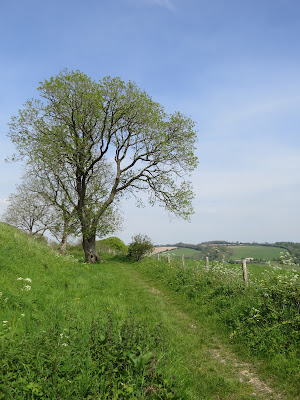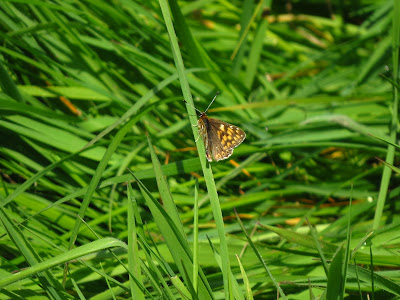First off, I do believe there is a rabid-madness in wanting to walk up and down very steep hills in Dorset looking for butterflies. Especially on a hot day. But that's what we adventurers do, after a leisurely hot chocolate beforehand of course.
It's been a busy few weeks, but with the weather set to be warm and fair I took the decision to take Friday off as leave and head down to Hod Hill in Dorset with Mrs Wessex-Reiver. My quest of course, the Duke of Burgundy butterfly. One had been seen here the day before, it promised to be a new site to explore. Which it was but by the time we'd trundled along in the car for nearly 2 and a half hours to get here the promised land yielded nothing more than many a brimstone, orange tip, speckled wood and a single very sleepy wall brown. Two butterflies were scrapping as we entered the hill but they flew off and were never to be seen again. Had they been the Dukes?

What were seen were skylarks, it's a long time since I've seen so many, very good views too and their song pierced the afternoon air. I like Hod Hill but realised after climbing up the only-a-goat-could-climb-this steep slope that I'd been here before. On that one other occasion the hill was alive with yellowhammer. Funny how the mind forgets where the body has been. Despite no Duke of Burgundy today it was lovely to just sit on the hill and take in the views towards the Cranborne Chase, a superb part of England.
Wall Brown at Hod Hill
The weather continued fair on Saturday but after our ten hour day the day before we needed a quiet at-home Saturday. I however woke on Sunday feeling fidgety and decided on the spur of the moment to head to Giant's Hill at Cerne Abbas, just on my own this time as sensibly Mrs Wessex-Reiver couldn't face another long hot drive to then stand on a hill and slowly roast. I set off and she went back to bed.
Burnet Companion moth
After last years adventures here I knew where the Dukes would be. Like a seasoned professional I donned my butterfly hat, loaded my kit-bag and set off up the slope from the car park. That said, I'm sure this hill is getting steeper, but eventually after ten minutes of impersonating the Flying Scotsman I arrived at my spot.
Prime Duke of Burgundy habitat
Duke of Burgundy butterflies are really a woodland edge and glade species, they've simply moved to the lesser habitat of chalk grasslands as woodlands have stopped being worked properly, i.e. coppiced. On first arriving at the site there were a few tantalising glimpses of something but they turned out to be burnet companion, grizzled and dingy skippers, and setting up a right old rumpus along the brambles green hairstreak scrapping madly. More on those later. No Dukes though.
Dingy skipper
I sat down, the sun was warm and what better way to spend a Sunday morning than dozing on a Dorset hillside waiting for the Royal Family to arrive, and arrive they did eventually, or at least he did. Male Duke of Burgundy have two pairs of legs and are often conspicuously perched on a tall piece of vegetation where they buzz and harry anything that passes. Females are seen less often and though they look similar to the males, as females have three pairs of legs identifying the sexes is easy, as long as you obtain a good view. That is why binoculars are so important. I like my images for a historical record but sitting there viewing what I saw through my binoculars was the order of the day and allowed behaviour to be observed closely.
Male Duke of Burgundy above and below
I had to sit for about ten minutes before the first Duke of Burgundy arrived, and it always catches me out how small this butterfly, with such a grand sounding name, actually is. The skippers are about the same size and with these plus the burnet companion wafting back and forth finding the Dukes required patience and a lot of checking, I was glad then to be just relaxing and taking in the view until a Duke finally came into view. A couple of other butterfly people came past but generally it was a quiet day on the hillside, just the butterflies and me.
Grizzled skipper
His Grace poised for combat
I'd been sitting for about twenty minutes and the activity was slowing down. The green hairstreak had stopped fighting, the Dukes had disappeared, even the skippers hid from view. I rose and went for a little wander, peacock, orange tip, a lot of brimstone, a 'blue' briefly appeared which I'd assumed was a common. In the shady woodland at the bottom of the slope a number of speckled wood and large white were in evidence, and a red admiral. It was nice in here, shady and well hidden. There was a cattle trough nearby, I had a look, the water was clear and devoid of plant life but full of lesser water boatmen. That made me wonder why they come to these troughs, there's little cover and being a trough they'll be trapped here until they die, or get eaten by cattle while having a drink.
I walked back to my earlier observation spot, sat down again and waited. Before too long this obliging male Duke of Burgundy alighted on top of a dandelion. A perfect look-out, it repeatedly flew off to chase away anything which passed before returning again. I like that. I liked sitting quietly and just observing this male defending it's territory, going about its business in it's own quiet way.
I've included these two images below as an example of how butterflies are usually seen. We've all observed that close-up image of a butterfly, every scale or hair pin sharp and perfect. Well in reality it is not like that, most images are obscured by vegetation and distance. Try and get closer and the butterfly will fly off in a nano-second. No these two images of a male are very much the norm.
Speckled wood underwing
I needed to stretch my legs once more so arising I went for a bit of a wander, not really looking for anything simply looking about the hillside and find a spot to have lunch. (one banana and a flask of water). Suitably perched I sat for half an hour looking over the valley towards Telegraph Hill. Over there is the best Duke of Burgundy site in Dorset but it is on private land. I've walked the footpath across the hill before but not seen anything. The best habitat is off limits but I did wonder whether these largely sedentary butterflies fly between these two sites, maybe a mile apart? Lunch over, with the heat really starting to kick in I thought of returning to the car, but before that one last look at the place I'd been to earlier. What a difference.

I was watching this male, for once not obscured by grass leaves when a whirling dervish pair of scrapping green hairstreak caught my eye. They separated and one perched on a bramble stem, which, when I looked closer, also contained a pair of mating Dukes. What a surprise to discover these and they mesmerised me for nearly 15 minutes. In the image below the male is on the left. Such a treat to see as this, the next generation of what is now a rare butterfly, being consumated right in front of my eye. The population of Dukes on Giant Hill isn't huge anyway, I maybe saw a handful individuals during three hours of continuous observation today. There are many primroses and cowslips around here too, suitable sites then for egg laying afterwards.

One of the other identification tips for the sexes is the female has more rounded wings compared to the male. That may be the case with perfect specimens or views, but it's a lot more difficult in real life, even when this close. I was fascinated however on how they remained embraced and motionless for such a long time, around fifteen minutes before they separated, leaving them quite vulnerable to predators in many ways. But actually if I stepped back a little they blended superbly into the brambles, remaining motionless is an advantage too. Lets not forget either that bramble is such an important plant in the British landscape.

More fighting by the green hairstreak close by reminded me I'd not paid them much attention. They really are stunning, like miniature flying emeralds, though when in flight they look a pale olive-brown. But once settled, with wings closed their underwing reveals an outrageous Day-Glo zingy green, yet they blend in perfectly with the surrounding vegetation. Even viewed close to they're often hard to see at first, especially if seen head on, even harder to photograph well. Lucky then that the males after aerial combat return to a promenant perch at about head hight to await their next battle. They really are beautiful, the underwing, which is all you'd ever see while they are resting, is like a green mother of pearl, it sheens with an iridescence, like an oil drop on water, yet with that thin brown wing edge delineating the warm brown upper wings which are virtually impossible to see.
Even something that green seems camouflaged
The white dots in a line giving it it's name on the underwing are visible here.
I checked on the Dukes - still at it.
But I can't get enough of these green hairstreak
What a wonderful day with possibly the best part of it being time spent sitting quietly watching the butterflies going about their business, no photographs, no making notes, no trying to get closer, simply sitting and watching. While doing this a couple walked by me and asked if I was okay. I replied I was but after they'd left it struck me no other people on the hill during the time I was there had actually stopped and watched wildlife for more than a few seconds, they just kept on walking, even if slowly. Such an important lesson to learn, inactivity and observation can reap rewards, I suggest sitting for no less than half an hour in one place, wildlife will come to you, what a treat awaits.






















































